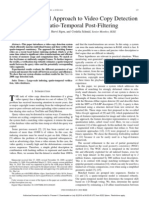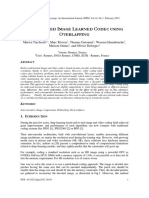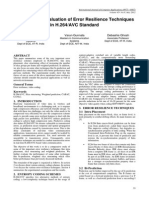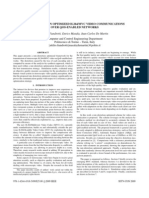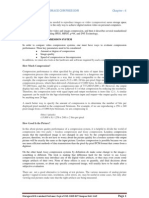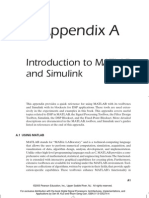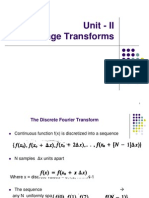The Lecture Contains:: Lecture 41: Performance Measures, Intraframe Coding, Predictive and Transform Coding
The Lecture Contains:: Lecture 41: Performance Measures, Intraframe Coding, Predictive and Transform Coding
Uploaded by
Adeoti OladapoCopyright:
Available Formats
The Lecture Contains:: Lecture 41: Performance Measures, Intraframe Coding, Predictive and Transform Coding
The Lecture Contains:: Lecture 41: Performance Measures, Intraframe Coding, Predictive and Transform Coding
Uploaded by
Adeoti OladapoOriginal Title
Copyright
Available Formats
Share this document
Did you find this document useful?
Is this content inappropriate?
Copyright:
Available Formats
The Lecture Contains:: Lecture 41: Performance Measures, Intraframe Coding, Predictive and Transform Coding
The Lecture Contains:: Lecture 41: Performance Measures, Intraframe Coding, Predictive and Transform Coding
Uploaded by
Adeoti OladapoCopyright:
Available Formats
Objectives_template
Module 8: Video Coding Basics
Lecture 41: Performance measures, Intraframe coding, Predictive and transform coding
The Lecture Contains:
Performance Measures
Intraframe Coding
file:///D|/...Ganesh%20Rana)/MY%20COURSE_Ganesh%20Rana/Prof.%20Sumana%20Gupta/FINAL%20DVSP/lecture%2041/41_1.htm[12/31/2015 11:55:56 AM]
Objectives_template
Module 8: Video Coding Basics
Lecture 41: Performance measures, Intraframe coding, Predictive and transform coding
Performance Measures
(unitless), (8.7)
(8.15)
(bits/pel), (8.8)
(8.16)
(bits/s), (8.9)
Another important aspect is the reconstruction quality. This can be assessed using a number of
subjective and objective measures.
Subjective measures are normally evaluated by showing the reconstructed video to a group of
subjects and asking for their views on the perceived quality. A number of subjective assessment
methodologies have been developed over the years. Examples are the double stimulus impairment
scale (DSIS) and the double and single stimulus continuous quality scales, (DSCQS) and (SSCQS),
respectively. Despite their reliability, subjective quality experiments are expensive and time
consuming.
Objective measures provide cheaper and faster alternatives. One commonly used objective measure
is the mean squared error (MSE), which is defined as
(8.10)
Where H and V are the horizontal and vertical dimensions of the frame, respectively, and
and are the pel values at location of the original and reconstructed frames,
respectively. Care should be taken to include color components and to take into account any chroma
subsampling. For example, the MSE of a reconstructed 4:2:0 color frame can be calculated as
(8.11)
file:///D|/...Ganesh%20Rana)/MY%20COURSE_Ganesh%20Rana/Prof.%20Sumana%20Gupta/FINAL%20DVSP/lecture%2041/41_2.htm[12/31/2015 11:55:56 AM]
Objectives_template
Module 8: Video Coding Basics
Lecture 41: Performance measures, Intraframe coding, Predictive and transform coding
A more common form of the MSE measure is the peak signal-to-noise ratio (PSNR), which is defined
as
(dB), (8.12)
Where is the maximum possible pel value (for example, 255 for an 8-bit resolution component).
Although this measure does not always correlate well with perceived video quality, its relative
simplicity makes it a very popular choice in the video coding community. Thus, to facilitate
comparisons with other algorithms reported in the literature, we adopt the PSNR measure. If
accuracy is a major concern, then more sophisticated objective measures based on perceptual
models can be used.
When testing a video coding algorithm, it is very important to subject it to a range of input video
sequences with different characteristics and a reasonable
Figure 8.3: Three test sequences
spread of data properties. The Moving Picture Experts Group (MPEG) established a library of CCIR-
601 test sequences divided into five classes: class A (low spatial detail and low amount of motion),
class B (medium spatial detail and low amount of motion or vice versa), class C (high spatial detail
and medium amount of motion, or vice versa), class D (stereoscopic), and class E (hybrid of natural
and synthetic content) . The first three classes are more relevant for discussion. Thus, the discussion
in this module uses three test sequences: FOREMAN, AKIYO, and TABLE TENNIS, where each
sequence is a representative of one of the three relevant classes, A,B, and C, respectively. The three
sequences are at QSIF resolution and include 300 frames each. This resolution is typical of the
sequences used in very-low-bit-rate applications. Both AKIYO and TABLE TENNIS have luma
components of 176 x 120 and a frame rate of 30 frames/s, where FOREMAN has a luma component
of 176 x 144 and a frame rate of 25 frames/s. Figure 8.3 shows the luma component of the first
frame of each of the three test sequences.
file:///D|/...Ganesh%20Rana)/MY%20COURSE_Ganesh%20Rana/Prof.%20Sumana%20Gupta/FINAL%20DVSP/lecture%2041/41_3.htm[12/31/2015 11:55:57 AM]
Objectives_template
Module 8: Video Coding Basics
Lecture 41: Performance measures, Intraframe coding, Predictive and transform coding
Intraframe Coding
Intraframe coding refers to video coding techniques that achieve compression by exploiting (reducing)
the high spatial correlation between neighboring pels within a video frame. Such techniques are also
known as spatial redundancy reduction techniques or still-image coding techniques.
1) Predictive Coding
Predictive coding was originally proposed by Cutler in 1952. In this method, a number of previously
coded pels are used to form a prediction of the current pel. The difference between the pel and its
prediction forms the signal to be coded. Obviously, the better the prediction, the smaller the error
signal and the more efficient the coding system.
(a) Encoder (b) Decoder
Figure 8.4: Block diagram of a predictive coding system.
At the decoder, the same prediction is produced using previously decoded pels, and the received
error signal is added to reconstruct the current pel. A block diagram of a predictive coding system is
depicted in Figure 8.4.
Predictive coding is commonly referred to as differential pulse code modulation (DPCM). A special
case of this method is delta modulation (DM), which quantizes the error signal using two quantization
levels only.
Predictive coding can take many forms, depending on the design of the predictor and the quantizer
blocks. The predictor can use a linear or a nonlinear function of the previously decoded pels, it can
be 1-D (using pels from the same line) or 2-D (using pels from the same line and from previous
lines), and it can be fixed or adaptive. The quantizer also can be uniform or nonuniform, and it can be
fixed or adaptive.
file:///D|/...Ganesh%20Rana)/MY%20COURSE_Ganesh%20Rana/Prof.%20Sumana%20Gupta/FINAL%20DVSP/lecture%2041/41_4.htm[12/31/2015 11:55:57 AM]
Objectives_template
Module 8: Video Coding Basics
Lecture 41: Performance measures, Intraframe coding, Predictive and transform coding
The minimal storage and processing requirements were partly responsible for the early popularity of
this method, when storage and processing devices were scarce and expensive resources. The
method, however, provides only a modest amount of compression. In addition, its performance is
highly dependent on the statistics of the input data, and it is very sensitive to errors (feedback through
the prediction loop can cause error propagation). As processing and storage devices became more
available, more complex, more efficient methods like transform coding have become more popular.
Despite this, predictive coding is still used in video coding, as, for example, in the lossless coding of
motion vectors.
2) Transform Coding
Transform coding, developed more than two decades ago, has proven to be a very effective video
coding method. Today, it forms the basis of almost all video coding standards. Figure 8.5 shows a
block diagram of a typical transform coding system. The input frame is first segmented into
blocks.
(a) Encoder
(b) Decoder
Figure 8.5: Block diagram of a transform coding system
file:///D|/...Ganesh%20Rana)/MY%20COURSE_Ganesh%20Rana/Prof.%20Sumana%20Gupta/FINAL%20DVSP/lecture%2041/41_5.htm[12/31/2015 11:55:57 AM]
Objectives_template
Module 8: Video Coding Basics
Lecture 41: Performance measures, Intraframe coding, Predictive and transform coding
A unitary space-frequency transform is applied to each block to produce a block of transform
(spectral) coefficients that are then suitably quantized and coded. At the decoder, an inverse
transform is applied to reconstruct the frame.
The main goal of the transform is to decorrelate the pels of the input block. This is achieved by
redistributing the energy of the pels and concentrating most of it in a small set of transform
coefficients. This is known as energy compaction. The transform process can also to interpreted as
a coordinate rotation of the input or as a decomposition of the input into orthogonal basis functions
weighted by the transform coefficients.
Compression comes about from two main mechanisms. First, low-energy coefficients can be
discarded with minimum impact on the reconstruction quality. Second, the HVS has differing
sensitivity to different frequencies. Thus, the retained coefficients can be quantized according to their
visual importance.
When choosing a transform, three main properties are desired: good energy compaction, data-
independent basis functions, and fast implementation.
The Karhunen-Loeve transform (KLT) is the optimal transform in an energy-compaction sense.
Unfortunately, this optimality is due to the fact that the KLT basis functions are dependent on the
covariance matrix of the input block. Recomputing and transmitting basis functions for each block are
a nontrivial computational task. These disadvantages severely limit the use of the KLT in practical
coding systems.
The performance of many suboptimal transforms with data-independent basis functions has been
studied. Examples are the discrete Fourier transform (DFT), the discrete cosine transform (DCT), the
Walsh-Hadamard transform (WHT), and the Haar transform. It has been demonstrated that the DCT
has the closest energy-compaction performance to that of the optimum KLT. This has motivated the
development of a number of fast DCT algorithms Due to these attractive features, i.e., near-
optimum energy-compaction, data-independent basis functions and fast algorithms, the DCT
has become the "workhorse" of most image and video coding standards .
file:///D|/...Ganesh%20Rana)/MY%20COURSE_Ganesh%20Rana/Prof.%20Sumana%20Gupta/FINAL%20DVSP/lecture%2041/41_6.htm[12/31/2015 11:55:57 AM]
Objectives_template
Module 8: Video Coding Basics
Lecture 41: Performance measures, Intraframe coding, Predictive and transform coding
The DCT was developed by Ahmed et.al. in 1974. There are four slightly different versions of the
DCT, but the one commonly used for video coding is denoted by DCT-II. The 2-D DCT-II of an
block of pels is given by
(8.13)
where is the pel value at location within the block, is the corresponding
transform coefficient, and
(8.14)
The transform coefficient F(0,0) at the top-left corner of the transformed block is called the DC
coefficient because it contains the lowest frequencies in both the horizontal and vertical dimensions.
The corresponding inverse DCT transform is given by
(8.15
)
It can be deduced from Equation (8.13) that the computational complexity of an 2-D DCT is of
the order . However, one of the advantages of the DCT is that it is separable. This means
that a 2-D DCT can be separated into a pair of 1-D DCTs. Thus, to obtain the 2-D DCT of an
block, a 1-D DCT is performed first on each of the N rows of the block and then on each of the N
columns of the resulting block (or vice versa). The same applies to the inverse DCT. This reduces
the complexity to . Further reductions in complexity can be achieved using a number of fast
DCT algorithms.
file:///D|/...Ganesh%20Rana)/MY%20COURSE_Ganesh%20Rana/Prof.%20Sumana%20Gupta/FINAL%20DVSP/lecture%2041/41_7.htm[12/31/2015 11:55:58 AM]
Objectives_template
Module 8: Video Coding Basics
Lecture 41: Performance measures, Intraframe coding, Predictive and transform coding
Beside transform selection, a significant factor that affects tr ansform coding performance and
computational complexity is the block size. In general, the
Figure 8.6: Transform coefficient bit allocation
use of smaller block sizes reduces computational complexity. However, as will be discussed later,
transform coding suffers from blocking artifacts at very low bit rates. Such artifacts are more
disturbing with smaller block sizes. As a compromise between computational complexity and blocking
artefacts, most transform coding systems employ a block size of 8 x 8 or 16 x 16. Note that both
sizes are powers of 2, which simplifies computations.
Another important factor in transform coding is bit allocation. This refers to the process of determining
which coefficients should be retained for coding and how coarsely each retained coefficient should be
quantized. There are two main approaches: zonal coding and threshold coding. In zonal coding the
retained coefficients are selected on the basis of maximum variance. Thus, the locations of the
retained coefficients with the largest variances are indicated by a zonal mask that is the same for all
blocks. Once the retained coefficients are decided, a number of methods can be used to decide the
number of bits allocated to each. One method is to choose the number of bits to be proportional to
the variance of the coefficient. Figure 8.6(a) shows a zonal mask with the allocated bits. Once the
number of bits allocated for each coefficient is determined, a different quantizer can be designed for
each coefficient.
file:///D|/...Ganesh%20Rana)/MY%20COURSE_Ganesh%20Rana/Prof.%20Sumana%20Gupta/FINAL%20DVSP/lecture%2041/41_8.htm[12/31/2015 11:55:58 AM]
Objectives_template
Module 8: Video Coding Basics
Lecture 41: Performance measures, Intraframe coding, Predictive and transform coding
One disadvantage of zonal coding is that the locations of the retained coefficients and the bits
allocated to them are fixed for all blocks. In threshold coding, however, the locations and the bit
allocation can be adapted to the characteristics of the block. For this reason, this method is
employed by most video coding standards. In threshold coding, the retained coefficients are selected
on the basis of maximum magnitude. Thus, only those coefficients whose magnitudes are above a
threshold are retained. In practice, the thresholding and the following quantization operations are
combined in one operation using a uniform threshold quantizer. In this case, a quantization matrix is
used to define the quantizer step size, for each coefficient in the block.
A typical quantization matrix is given in Figure 8.6(b). Note that low-frequency coefficients (towards
top-left corner) are more finely quantized (i.e., quantized with a smaller step size) because of two
reasons. First, the DCT tends to concentrate most of the energy in low frequencies. Second, the HVS
is more sensitive to variations in low frequencies. Since in threshold coding the locations of the
retained coefficients vary from block to block, those locations need to be encoded. A commonly used
strategy is to zigzag scan the transform coefficients, as illustrated in Figure 8.6(c), in an attempt to
produce long runs of zeros, and then RLE is used to encode the resulting array.
Compared to predictive coding, transform coding provides higher compression with less sensitivity to
errors and less dependence on the input data statistics. Its higher computational complexity and
storage requirements have been offset by advances in integrated circuit technology. One
disadvantage, however, is that when compression factors are pushed to the limit, three types of
artefacts start to occur: (i) "graininess" due to coarse quantization of some coefficients, (ii) "blurring"
due to the truncation of high-frequency coefficients, and (iii) "blocking artifacts," which refer to
artificial discontinuities appearing at the borders of neighboring blocks due to independent processing
of each block. Since blocking artefacts are the most disturbing, a number of methods have been
proposed to reduce them. Examples are overlapping blocks at the encoder, the use of the lapped
orthogonal transform , and postprocessing using filtering and image restoration techniques.
file:///D|/...Ganesh%20Rana)/MY%20COURSE_Ganesh%20Rana/Prof.%20Sumana%20Gupta/FINAL%20DVSP/lecture%2041/41_9.htm[12/31/2015 11:55:58 AM]
You might also like
- A Hybrid Algorithm For Effective Lossless Compression of Video Display FramesDocument10 pagesA Hybrid Algorithm For Effective Lossless Compression of Video Display FramesHelder NevesNo ratings yet
- A Hybrid Transformation Technique For Advanced Video Coding: M. Ezhilarasan, P. ThambiduraiDocument7 pagesA Hybrid Transformation Technique For Advanced Video Coding: M. Ezhilarasan, P. ThambiduraiUbiquitous Computing and Communication JournalNo ratings yet
- A Different Approach For Spatial Prediction and Transform Using Video Image CodingDocument6 pagesA Different Approach For Spatial Prediction and Transform Using Video Image CodingInternational Organization of Scientific Research (IOSR)No ratings yet
- High Efficiency Video Coding With Content Split Block Search Algorithm and Hybrid Wavelet TransformDocument7 pagesHigh Efficiency Video Coding With Content Split Block Search Algorithm and Hybrid Wavelet TransformSai Kumar YadavNo ratings yet
- Wavelet Video Processing Technolog Full ReportDocument20 pagesWavelet Video Processing Technolog Full ReportKrishna Kumari Sahoo100% (1)
- A Characteristics-Based Bandwidth Reduction Technique For Pre-Recorded VideosDocument4 pagesA Characteristics-Based Bandwidth Reduction Technique For Pre-Recorded Videosalokcena007No ratings yet
- KFEDocument4 pagesKFESumeetKateNo ratings yet
- Analysing Jpeg Coding With MaskingDocument10 pagesAnalysing Jpeg Coding With MaskingIJMAJournalNo ratings yet
- Lossless Compression in MPEG4 Videos: K.Rajalakshmi, K.MaheshDocument4 pagesLossless Compression in MPEG4 Videos: K.Rajalakshmi, K.MaheshShakeel RanaNo ratings yet
- An Image-Based Approach To Video Copy Detection With Spatio-Temporal Post-FilteringDocument10 pagesAn Image-Based Approach To Video Copy Detection With Spatio-Temporal Post-FilteringAchuth VishnuNo ratings yet
- Key-Frame Detection in Raw Video StreamsDocument10 pagesKey-Frame Detection in Raw Video StreamsQuốc ThắngNo ratings yet
- Lip2 Speech ReportDocument7 pagesLip2 Speech Reportshivammittal200.smNo ratings yet
- Efficient and Robust Video Compression Using Huffman CodingDocument4 pagesEfficient and Robust Video Compression Using Huffman CodingRizal Endar WibowoNo ratings yet
- Sequence Matching TechniquesDocument8 pagesSequence Matching TechniquesselimarikanNo ratings yet
- Literature Review On Different Compression TechniquesDocument5 pagesLiterature Review On Different Compression TechniquesInternational Journal of Application or Innovation in Engineering & ManagementNo ratings yet
- Improved Error Detection and Data Recovery Architecture For Motion Estimation Testing ApplicationsDocument7 pagesImproved Error Detection and Data Recovery Architecture For Motion Estimation Testing Applicationssammy05jonesNo ratings yet
- 2 2010 A Digital Robust Video Watermarking Using 4 Level DWTDocument13 pages2 2010 A Digital Robust Video Watermarking Using 4 Level DWTRakesh AhujaNo ratings yet
- Error Detection and Data Recovery Architecture For Motion EstimationDocument63 pagesError Detection and Data Recovery Architecture For Motion Estimationkasaragadda100% (1)
- Image processing compressionDocument12 pagesImage processing compressionFerdaws OmarNo ratings yet
- A Hybrid Image and Video Compression of DCT and DWT Techniques For H.265/HEVCDocument5 pagesA Hybrid Image and Video Compression of DCT and DWT Techniques For H.265/HEVCmuneeb rahmanNo ratings yet
- The Lecture Contains:: Lecture 4: Introducing Digital Video and Digital Video StandardsDocument6 pagesThe Lecture Contains:: Lecture 4: Introducing Digital Video and Digital Video StandardsKarajá PtahNo ratings yet
- A Shot Boundary Detection Technique Based On Visual Colour InformationDocument16 pagesA Shot Boundary Detection Technique Based On Visual Colour Informationnishmithapoojary1301No ratings yet
- Analysis and Implementation of Video Compression Using MPEG StandardDocument13 pagesAnalysis and Implementation of Video Compression Using MPEG StandardElbahlul FgeeNo ratings yet
- Patch-Based Image Learned Codec Using OverlappingDocument21 pagesPatch-Based Image Learned Codec Using OverlappingsipijNo ratings yet
- A Genetic Algorithm-Based 3D Feature Selection For Lip ReadingDocument6 pagesA Genetic Algorithm-Based 3D Feature Selection For Lip ReadingSuprava PatnaikNo ratings yet
- Selection of Optimal Solution For Example and Model of Retrieval Based Voice ConversionDocument8 pagesSelection of Optimal Solution For Example and Model of Retrieval Based Voice ConversionluzpachecoblNo ratings yet
- Fast Encryption Algorithm For Streaming Video Over Wireless NetworksDocument4 pagesFast Encryption Algorithm For Streaming Video Over Wireless NetworksInternational Journal of computational Engineering research (IJCER)No ratings yet
- Implement A Vision On A LLMDocument21 pagesImplement A Vision On A LLMKayky RamosNo ratings yet
- Error Resiliency Schemes in H.264/AVC StandardDocument26 pagesError Resiliency Schemes in H.264/AVC StandardDam Minh TungNo ratings yet
- Performance Evaluation of Error Resilience Techniques in H.264AVC StandardDocument7 pagesPerformance Evaluation of Error Resilience Techniques in H.264AVC Standardaryandubey01No ratings yet
- DWT SpihtDocument8 pagesDWT SpihtPavan GaneshNo ratings yet
- Using Hybrid Algorithm An Efficient Lossless Medical Image CompressionDocument6 pagesUsing Hybrid Algorithm An Efficient Lossless Medical Image CompressionSundaraPandiyanNo ratings yet
- Beginner Guide For MPEG-2 StandardDocument12 pagesBeginner Guide For MPEG-2 StandardFirdaus SikumbangNo ratings yet
- SDXL ReportDocument21 pagesSDXL ReportJohn SmithNo ratings yet
- Image DatabaseDocument16 pagesImage Databasemulayam singh yadavNo ratings yet
- Ip 58 678 684 PDFDocument7 pagesIp 58 678 684 PDFlambanaveenNo ratings yet
- A Low Complexity Embedded Compression Codec Design With Rate Control For High Definition VideoDocument14 pagesA Low Complexity Embedded Compression Codec Design With Rate Control For High Definition Videodev- ledumNo ratings yet
- Compusoft, 2 (5), 127-129 PDFDocument3 pagesCompusoft, 2 (5), 127-129 PDFIjact EditorNo ratings yet
- Robust Video Watermarking Using DWT and PCA Analysis: IPASJ International Journal of Electronics & Communication (IIJEC)Document6 pagesRobust Video Watermarking Using DWT and PCA Analysis: IPASJ International Journal of Electronics & Communication (IIJEC)International Journal of Application or Innovation in Engineering & ManagementNo ratings yet
- 978-1-4244-4318-5/09/$25.00 C °2009 IEEE 3DTV-CON 2009Document4 pages978-1-4244-4318-5/09/$25.00 C °2009 IEEE 3DTV-CON 2009lido1500No ratings yet
- Major Project Synopsis1-NewDocument13 pagesMajor Project Synopsis1-NewShivani goswamiNo ratings yet
- Video Saliency Detection Using Modified High Efficiency Video Coding and Background ModellingDocument10 pagesVideo Saliency Detection Using Modified High Efficiency Video Coding and Background ModellingIJRES teamNo ratings yet
- Multmedia StudiesDocument15 pagesMultmedia StudiesDevson SimonNo ratings yet
- Video Coding and A Mobile Augmented Reality ApproachDocument10 pagesVideo Coding and A Mobile Augmented Reality Approachvfotop1No ratings yet
- Gip Unit 5 - 2018-19 EvenDocument36 pagesGip Unit 5 - 2018-19 EvenKalpanaMohanNo ratings yet
- EHaCON - 2019 Paper 8Document20 pagesEHaCON - 2019 Paper 8Himadri Sekhar DuttaNo ratings yet
- Video Shot Boundary Detection Using Hybrid Dual Tree Complex Wavelet Transform With Walsh Hadamard TransformDocument27 pagesVideo Shot Boundary Detection Using Hybrid Dual Tree Complex Wavelet Transform With Walsh Hadamard Transformnishmithapoojary1301No ratings yet
- In Communications Based On MATLAB: A Practical CourseDocument10 pagesIn Communications Based On MATLAB: A Practical Coursesakhtie1No ratings yet
- Fast Block Direction Prediction For Directional TransformsDocument8 pagesFast Block Direction Prediction For Directional TransformsCyberJournals MultidisciplinaryNo ratings yet
- Scalable Rate ControlDocument17 pagesScalable Rate Controlc.sowndaryaNo ratings yet
- Advances in Video Compression: Jens-Rainer OhmDocument5 pagesAdvances in Video Compression: Jens-Rainer OhmNguyễn Duy HiềnNo ratings yet
- HEVC Deblocking FilterDocument9 pagesHEVC Deblocking FilterkbrinaldiNo ratings yet
- An Overview of Recent Video Coding Developments in Mpeg and AomediaDocument9 pagesAn Overview of Recent Video Coding Developments in Mpeg and AomediaAnonymous RHXmnbTNo ratings yet
- Artigo CientíficoDocument6 pagesArtigo CientíficoRuhan ConceiçãoNo ratings yet
- Video Summarization and Retrieval Using Singular Value DecompositionDocument12 pagesVideo Summarization and Retrieval Using Singular Value DecompositionIAGPLSNo ratings yet
- A PDFDocument6 pagesA PDFpoojaNo ratings yet
- Digital Video ProcessingDocument19 pagesDigital Video ProcessingArjun Hande0% (1)
- Simulation Based Watermarking For Confidential Data Security For Video SignalDocument4 pagesSimulation Based Watermarking For Confidential Data Security For Video Signaleditor_ijarcsseNo ratings yet
- Image Compression: Efficient Techniques for Visual Data OptimizationFrom EverandImage Compression: Efficient Techniques for Visual Data OptimizationNo ratings yet
- Human Visual System Model: Understanding Perception and ProcessingFrom EverandHuman Visual System Model: Understanding Perception and ProcessingNo ratings yet
- Unit 12 - Week 10: Assignment 10Document5 pagesUnit 12 - Week 10: Assignment 10Adeoti OladapoNo ratings yet
- Unit 7 - Week 5: Assignment 5Document6 pagesUnit 7 - Week 5: Assignment 5Adeoti OladapoNo ratings yet
- Unit 6 - Week 4: Assignment 4Document5 pagesUnit 6 - Week 4: Assignment 4Adeoti OladapoNo ratings yet
- Unit 5 - Week 3: Assignment 3Document6 pagesUnit 5 - Week 3: Assignment 3Adeoti OladapoNo ratings yet
- Unit 4 - Week 2: Assignment 2Document6 pagesUnit 4 - Week 2: Assignment 2Adeoti OladapoNo ratings yet
- Unit 3 - Week 1: Assignment 1Document5 pagesUnit 3 - Week 1: Assignment 1Adeoti OladapoNo ratings yet
- Unit 2 - Week 0: Assignment 0Document5 pagesUnit 2 - Week 0: Assignment 0Adeoti OladapoNo ratings yet
- HYTORC J Washer Cut Sheet 021320 CompressedDocument2 pagesHYTORC J Washer Cut Sheet 021320 CompressedAdeoti OladapoNo ratings yet
- Design-Out Maintenance As A Crucial Maintenance Facet: Peter MuganyiDocument11 pagesDesign-Out Maintenance As A Crucial Maintenance Facet: Peter MuganyiAdeoti OladapoNo ratings yet
- Basics of Oil AnalysisDocument32 pagesBasics of Oil AnalysisAdeoti OladapoNo ratings yet
- Vibxpert Short EnglishDocument28 pagesVibxpert Short EnglishAdeoti OladapoNo ratings yet
- J Washer Market IntroductionDocument14 pagesJ Washer Market IntroductionAdeoti OladapoNo ratings yet
- Image Processing Methods For Biometric Applications: December 2014Document22 pagesImage Processing Methods For Biometric Applications: December 2014ummay rubabNo ratings yet
- Signal Analysis and TransformDocument3 pagesSignal Analysis and TransformravindrapadsalaNo ratings yet
- An Introduction To Compressive SensingDocument118 pagesAn Introduction To Compressive SensingctzagNo ratings yet
- CrypticCare A Strategic Approach To Telemedicine Security Using LSB and DCT Steganography For Enhancing The Patient Data ProtectionDocument18 pagesCrypticCare A Strategic Approach To Telemedicine Security Using LSB and DCT Steganography For Enhancing The Patient Data ProtectionDIKSHANT SHARMANo ratings yet
- DCT For Speech CompressionDocument21 pagesDCT For Speech CompressionSangeeth reddy podilaNo ratings yet
- Imageprocessing PaperDocument13 pagesImageprocessing PaperCol. Jerome Carlo Magmanlac, ACPNo ratings yet
- Chapter 6: DIGITAL VIDEO AND IMAGE COMPRESSIONDocument9 pagesChapter 6: DIGITAL VIDEO AND IMAGE COMPRESSIONபாவரசு. கு. நா. கவின்முருகுNo ratings yet
- Digital Image ProcessingDocument40 pagesDigital Image ProcessingAltar TarkanNo ratings yet
- Matlab DSPDocument0 pagesMatlab DSPNaim Maktumbi NesaragiNo ratings yet
- A Project On Digital Watermarking Using MatlabDocument24 pagesA Project On Digital Watermarking Using MatlabAjith P ShettyNo ratings yet
- Advanced Digital Signal Processing TutorDocument29 pagesAdvanced Digital Signal Processing TutorMiklos PothNo ratings yet
- CH: 7 Fundamentals of Video CodingDocument13 pagesCH: 7 Fundamentals of Video Codingkd17209No ratings yet
- Deep Convolution Networks For Compression ArtifactDocument14 pagesDeep Convolution Networks For Compression Artifactai rednaNo ratings yet
- Digital Watermarking Algorithms and ApplicationsDocument15 pagesDigital Watermarking Algorithms and ApplicationsGiang le vanNo ratings yet
- Lecture 4: Non-Linear Filters & Image Compression: B14 Image Analysis Michaelmas 2014 A. ZissermanDocument54 pagesLecture 4: Non-Linear Filters & Image Compression: B14 Image Analysis Michaelmas 2014 A. ZissermanybNo ratings yet
- An Efficient Image Watermarking Method Based On FaDocument11 pagesAn Efficient Image Watermarking Method Based On FaLili CheNo ratings yet
- Assessment of PragmaticsDocument8 pagesAssessment of Pragmaticslife100% (1)
- Rad Appendix 07Document84 pagesRad Appendix 07Le ThangNo ratings yet
- Final Thesis Presentation SampleDocument8 pagesFinal Thesis Presentation SampleCustomWrittenPapersSingaporeNo ratings yet
- Mtech Mini Project Format-2020 - Ece, VceDocument14 pagesMtech Mini Project Format-2020 - Ece, VceKalyan Reddy AnuguNo ratings yet
- 2013 BijitDocument7 pages2013 BijitSushilKumar AzadNo ratings yet
- Unit - II Image TransformsDocument60 pagesUnit - II Image TransformsPillalamarri LaxmanNo ratings yet
- Kumbharana CK Thesis CsDocument243 pagesKumbharana CK Thesis CsYadu KrishnanNo ratings yet
- J1 - Mtap - 2020Document16 pagesJ1 - Mtap - 2020Saptarshi GhoshNo ratings yet
- Term Paper About Computer ScienceDocument8 pagesTerm Paper About Computer Sciencedelhwlwgf100% (1)
- Unit 5Document41 pagesUnit 5kokila.kNo ratings yet
- SisMul - Image Coding (Compression) - 07 - 2Document36 pagesSisMul - Image Coding (Compression) - 07 - 2Ekik ViknyNo ratings yet
- Continuous Arabic Sign Language Recognition in User Dependent ModeDocument9 pagesContinuous Arabic Sign Language Recognition in User Dependent ModeTaipe Lopez AndyNo ratings yet
- Great Pyramid of Giza and Golden Section Transform PreviewDocument26 pagesGreat Pyramid of Giza and Golden Section Transform Previewjasonli1880No ratings yet









